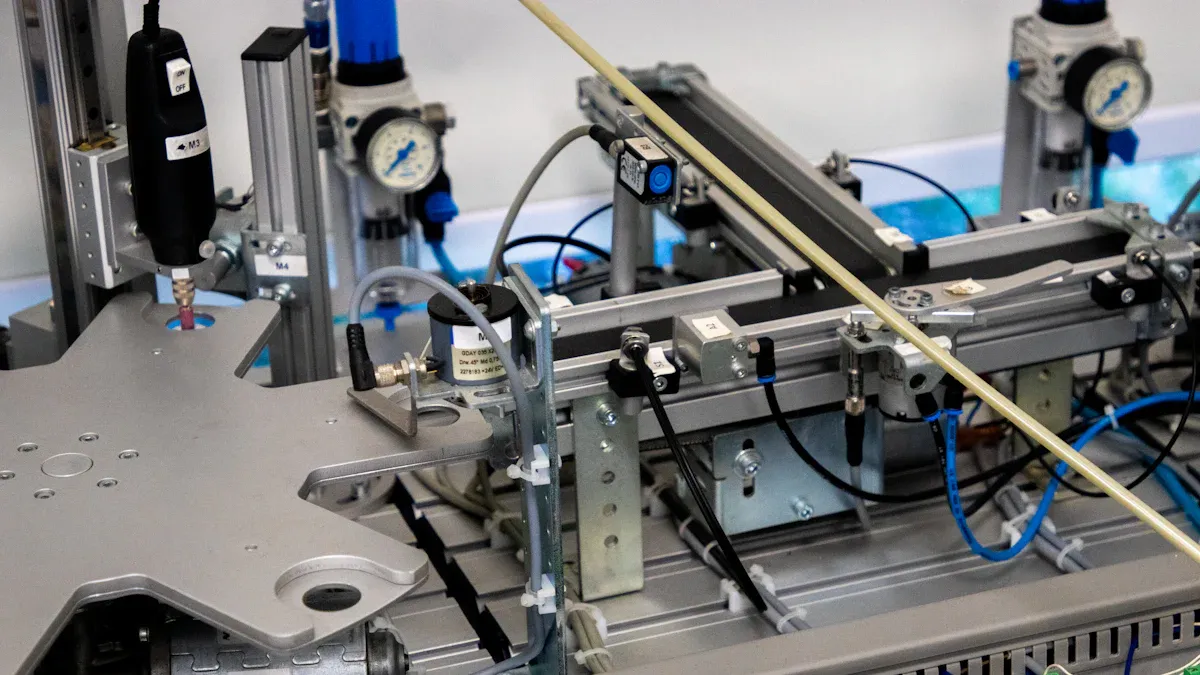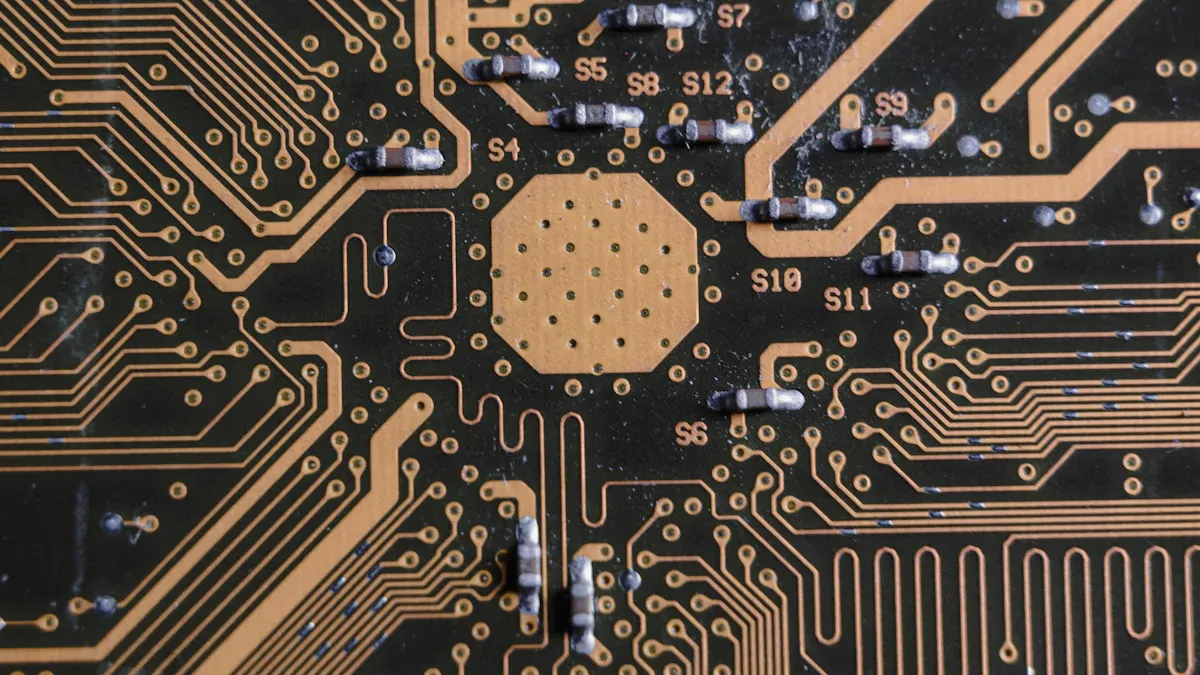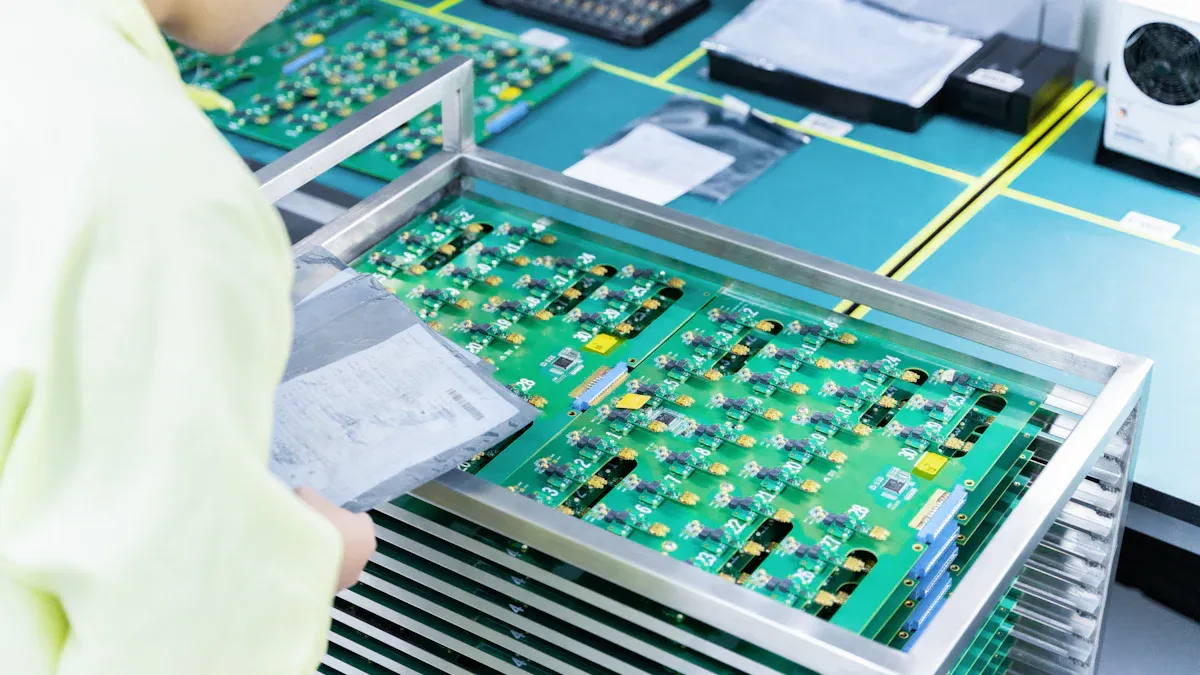The influence of vertical continuous electroplating (VCP) application on the uniformity of copper thickness in PCB production

Uniform copper thickness is very important for printed circuit boards (PCBs). It helps with good electricity flow, heat removal, and strength. For example:
Thick copper PCBs, over 3 oz/ft² (104 μm), carry up to 5 A.
Regular 1 oz copper traces carry only 1-1.5 A.
Vertical continuous electroplating makes copper thickness even across layers. This improves how well PCBs work and last.
Key Takeaways
Vertical continuous electroplating (VCP) makes copper layers even on PCBs. This helps them work better and last longer.
VCP works well for HDI boards. It fills tiny holes and adds exact copper layers for modern gadgets.
Picking LT CIRCUIT for VCP PCBs means great quality and trust. They use smart methods and focus on new ideas.
Understanding Vertical Continuous Electroplating (VCP) in PCB Manufacturing

What is vertical continuous electroplating?
Vertical continuous electroplating is a new way to coat PCBs. It adds copper evenly to all layers of the board. Unlike older methods, this process moves PCBs upright through special tanks. These tanks have solutions that control how copper is added. This method works well for HDI boards, which need exact details. By keeping copper ions (Cu²⁺) steady in the solution, it creates even coatings, even in hard-to-reach spots like tiny holes.
Why does this matter? Even copper thickness helps PCBs work better and last longer. This method also supports advanced designs, like micro-voids under 10 μm, which older methods can't fill well.
LT CIRCUIT's role in advancing VCP technology
LT CIRCUIT leads in improving vertical continuous electroplating. They use advanced tools and methods to make this process better. Their focus on quality ensures every PCB meets top standards.
LT CIRCUIT adapts VCP for many uses, like HDI or multi-layer boards. They’ve improved hole-filling for small holes, down to 45 micrometers. These updates show their dedication to better PCB production.
Comparison of VCP with traditional electroplating methods
Vertical continuous electroplating is better than older methods. Traditional ways often fail to make copper layers even. This can hurt PCB performance and reliability. VCP keeps copper layers consistent across all parts.
For example, older methods struggle with tiny voids under 10 μm. This can lower HDI board quality. VCP keeps copper ions steady, filling these small spaces perfectly. This makes it the best choice for modern PCB designs.
VCP also improves efficiency over time. The table below shows trends in PCB production that highlight VCP’s impact:
Evidence of Improvement | Description |
|---|---|
Better Equipment | New tools like vertical continuous electroplating improve production. |
Hole Filling | Smaller holes, down to 45 micrometers, are now filled easily. |
High-Density PCBs | Faster, multi-layer PCBs with better thickness and hole specs. |
These improvements show why VCP is key in today’s PCB manufacturing. Using this method gives better results for modern electronics.
The VCP Process and Its Role in Copper Thickness Uniformity

Main steps in the VCP process: preparation, electroplating, and post-treatment
The vertical continuous electroplating process has three main steps: preparation, electroplating, and post-treatment. Each step is important for making sure copper spreads evenly on PCB layers.
Preparation:
First, the PCB is cleaned to remove dirt or grease. This helps the copper stick well to the surface. Next, a special liquid with copper sulfate and other chemicals is made. This liquid controls how copper is added. Then, DSA anodes are placed carefully in the tank to spread electric current evenly.Electroplating:
Copper ions move from the anode to the cathode using electric power. This movement creates a smooth copper layer on the PCB. Adjusting the electric current and liquid flow helps make the copper spread evenly.Post-Treatment:
After plating, the PCB is washed and dried. This removes leftover liquid and keeps the board clean for the next steps.
Step | What Happens |
|---|---|
Cleaning | PCB is cleaned to remove dirt for better copper sticking. |
Liquid Preparation | A mix of copper sulfate and chemicals is made to control plating. |
Anode Placement | Anodes are placed in the tank to spread electric current evenly. |
Electroplating | Copper ions move to form a smooth layer on the PCB. |
Rinsing and Drying | PCB is washed and dried to remove extra liquid and stay clean. |
Important factors in VCP: current, liquid flow, and temperature
To make copper spread evenly, you need to control three things: current, liquid flow, and temperature.
Current:
Keeping the electric current steady helps copper grow smoothly. Studies show that stable current makes the copper layer even. This is very important for PCBs with tiny details like HDI boards.Liquid Flow:
Moving the liquid properly helps copper spread evenly. This is especially useful for PCBs with small or deep spaces. Good liquid flow ensures all areas get the same amount of copper.Temperature:
The liquid’s temperature affects how fast copper is added. Keeping the right temperature prevents problems like uneven layers or holes.
How VCP makes copper layers even on PCBs
Vertical continuous electroplating uses smart methods and chemicals to make copper layers even. Special leveling agents stop too much copper from building up in certain spots. High throw baths with unique additives help spread copper evenly, even with different electric currents.
Moving copper ions to all parts of the PCB is also important. Stirring and diffusion make sure copper reaches every corner, even in tricky designs. These techniques make VCP perfect for modern PCBs that need precise and even copper layers.
Tools are used to check if the copper layers are even. For example, eddy current gauges measure thickness without damaging the PCB. STEP methods, which are destructive, give detailed thickness results but ruin the sample. These tools ensure the process meets the required standards.
Tool | What It Does | Type of Test | Notes |
|---|---|---|---|
Eddy Current Gauge | Measures thickness without damaging the PCB using a magnetic field. | Non-destructive | May not work well on rough surfaces, affecting accuracy. |
STEP Method | Measures thickness by dissolving the surface layer. | Destructive | Gives detailed results but destroys the sample after testing. |
Benefits and Uses of Vertical Continuous Electroplating
Why VCP is Better: Uniformity, Growth, and Speed
Vertical continuous electroplating has many benefits for making PCBs. One big advantage is how it keeps copper thickness even, within ±2 µm. This accuracy helps PCBs meet strict rules like IPC-4552. It also makes them work better and last longer. VCP can be used for small tests or big productions. It works well with tricky designs like HDI boards while keeping quality high.
This method also checks for problems like gaps or uneven copper. It ensures every PCB meets the needed standards. Because of these features, VCP is very useful for industries like telecom and car manufacturing.
LT CIRCUIT's Skill in VCP PCB Making
LT CIRCUIT is a top company in vertical continuous electroplating. They use advanced tools and smart ideas to make high-quality PCBs. They are experts in making HDI PCBs with detailed designs for modern devices. LT CIRCUIT also creates special solutions, like DC acid copper via fill. This helps fill holes with less extra copper on the surface. Their focus on new ideas makes them a trusted choice for businesses needing great PCBs.
How VCP Helps in Real-Life PCB Making
Vertical continuous electroplating is important for many uses. It helps make HDI PCBs with tiny holes and thin lines. These are needed for small devices like phones and smartwatches. In cars, VCP helps make PCBs with thicker copper for electric vehicles. It is also key for 5G networks, helping control signals in telecom devices.
VCP improves the quality of plated through holes (PTHs). For example, testing 32,000 PTHs showed fewer unplated holes after process changes. This proves VCP makes production more accurate. Its ability to meet different needs makes it essential for advanced PCB making.
Vertical continuous electroplating keeps copper thickness the same on PCBs. Special methods like reverse-pulse plating help fill holes better. Good solution flow spreads copper evenly across all layers. LT CIRCUIT uses this to make strong, reliable PCBs. Their skills in new techniques make them a trusted choice for advanced boards.
FAQ
Why is VCP better than older electroplating methods?
VCP makes copper thickness even on all PCB layers. It uses smart methods like steady liquid flow and stable current. This improves how well modern designs work and last.
Can VCP work for high-density interconnect (HDI) boards?
Yes, VCP works great for HDI boards. It fills small holes and adds exact copper layers. This meets the needs of advanced devices like phones and 5G gadgets.
Why pick LT CIRCUIT for VCP-made PCBs?
LT CIRCUIT uses skill and new ideas to make great PCBs. Their VCP process keeps copper layers even, making them a trusted choice for advanced electronics.
💡 Tip: Check out LT CIRCUIT's website to learn about their VCP PCB options.
See Also
Utilizing Horizontal Copper Sinking Technology for PCB Manufacturing
Importance of Vacuum Two-Fluid Etching Machines in PCB Fabrication
Impact of LDI Technology on PCB Product Quality
